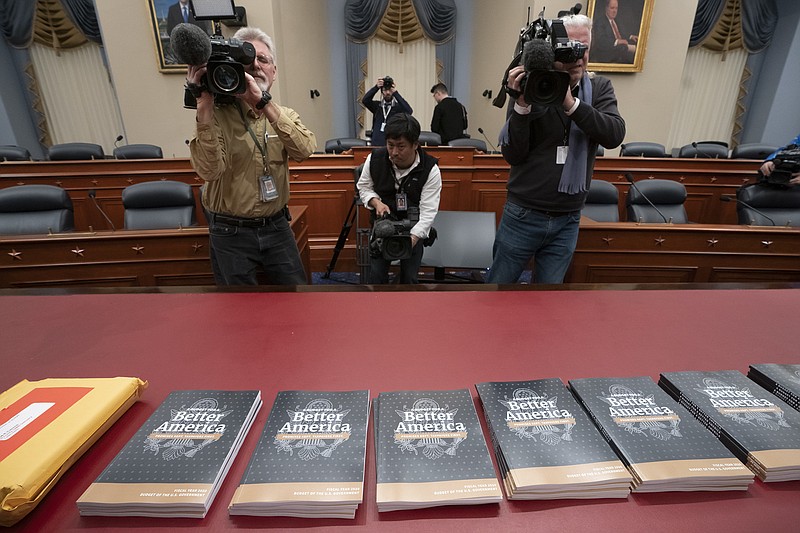WASHINGTON (AP) — President Donald Trump proposed a record $4.7 trillion federal budget for 2020 on Monday, relying on optimistic 3.1 percent economic growth projections alongside accounting shuffles and steep domestic cuts to bring future spending into promised balance in 15 years.
The deficit is projected to hit $1.1 trillion in fiscal year 2020, the highest in a decade. The administration is counting on robust growth, including from the Republican tax cuts — which Trump wants to make permanent — to push down the red ink. Some economists, though, said the bump from the tax cuts is waning, and they project slower growth in coming years. The national debt is $22 trillion.
Even with his own projections, Trump’s budget would not come into balance for a decade and a half, rather than the traditional hope of balancing in 10.
Still, Trump contended the nation is experiencing “an economic miracle.” He said in a letter to Congress accompanying the plan that the country’s next step must be “turbocharging the industries of the future and establishing a new standard of living for the 21st century.”
Presidential budgets tend to be seen as aspirational blueprints, rarely becoming enacted policy, and Trump’s proposal for the new fiscal year, which begins Oct. 1, sets up a showdown with Congress over priorities, including his push for $8.6 billion to build the U.S-Mexico border wall.
Titled “A Budget for a Better America: Promises Kept. Taxpayers First,” Trump’s proposal “embodies fiscal responsibility,” said Russ Vought, the acting director of the Office of Management and Budget.
Despite the large projected deficits, Vought said the administration has “prioritized reining in reckless Washington spending” and shows “we can return to fiscal sanity.”
The budget calls the approach “MAGAnomics,” after the president’s “Make America Great Again” campaign slogan.
Some fiscal watchdogs, though, panned the effort as more piling on of debt by Trump with no course correction in sight.
Maya MacGuineas, president of the Committee for a Responsible Federal Budget, said Trump “relies on far too many accounting gimmicks and fantasy assumptions and puts forward far too few actual solutions.” She warned the debt load will lead to slower income growth and stalled opportunities for Americans.
Perhaps most notably among spending proposals, Trump is reviving his border wall fight. Fresh off the longest government shutdown in history, his 2020 plan shows he is eager to confront Congress again over the wall.
Trump’s budget proposes increasing defense spending to $750 billion — and building the new Space Force as a military branch — while reducing nondefense accounts by 5 percent, with cuts recommended to economic safety-net programs used by many Americans. The $2.7 trillion in proposed spending cuts over the decade is higher than any administration in history, they say.
The budget imposes work requirements for those receiving food stamps and other government aid as part of the cutbacks. The Department of Housing and Urban Development faces a 16 percent cut and for Education, a 12 percent reduction.
Trump’s budget would re-open two health care battles he lost in his first year in office: repealing “Obamacare” and limiting future federal spending on Medicaid for low-income people. Under the budget, both programs would be turned over to the states starting in 2021.
The top Democrat on the Appropriation Committee, Sen. Patrick Leahy, of Vermont, said the budget is “not a serious proposal.”
By refusing to raise the budget caps, Trump is signaling a fight ahead. The president has resisted big, bipartisan budget deals that break the caps — threatening to veto one last year — but Congress will need to find agreement on spending levels to avoid another federal shutdown in the fall.
While pushing down spending in some areas, including the Environmental Protection Agency, the proposal will seek to increase funding in others to align with the president’s priorities, according to one official.
The administration would boost Veterans Affairs funding by $6.5 billion, or 7.5 percent, and said reducing veteran suicides would be a top priority.
The budget provides $291 million to “defeat the HIV/AIDS epidemic” with hopes of eliminating 90 percent of new infections within 10 years. It would also increase resources to fight the opioid epidemic with money for prevention, treatment, research and recovery, the administration said.
It provides $500 million in new spending over the decade on child cancer research.
The proposal will also include $1 billion for a child care fund that would seek to improve access to care for underserved populations, a White House official confirmed. The one-time allocation is championed by the president’s daughter Ivanka Trump, who has focused on economic advancement for women in her role as a White House adviser.
The border wall remains a signature issue for the president and is poised to stay at the forefront of his agenda, even though Congress has resisted giving him more money for it.
Leading Democrats immediately rejected the proposal.
“Congress refused to fund his wall and he was forced to admit defeat and reopen the government. The same thing will repeat itself if he tries this again,” said House Speaker Nancy Pelosi, D-Calif., and Senate Democratic leader Chuck Schumer, of New York. They said the money “would be better spent on rebuilding America.”

